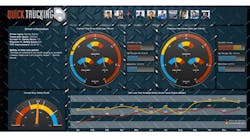The penetration rate of remote tracking systems used on intermodal shipping containers is estimated to increase from 0.7 percent in 2012 to 4.1 percent in 2017, according to a new research report from the analyst firm Berg Insight. The report states that the number of active remote container tracking units deployed on these containers was 137,000 in Q4-2012, up from 89,000 a year earlier. Growing at a compound annual growth rate (CAGR) of 49.1 percent, this number is expected to reach 1.0 million by 2017.
See Also: Increase ROI with Real-Time Visibility Applications
Berg Insight’s definition of a real-time container tracking solution is a system that incorporates data logging, satellite positioning and data communication to a back-office application.
The market for container tracking solutions is still in its early stages. Aftermarket solutions mounted on high value cargo and refrigerated containers are the first use cases to adopt container tracking. Orbcomm has, after its recent acquisitions of StarTrak, PAR LMS and GlobalTrak, emerged as the largest vendor of wireless container tracking devices, according to this report. Omnitracs, ID Systems and Skybitz are prominent vendors focusing on inland transportation in North America, which is so far the most mature market for container tracking solutions. Envotech, Pointer Telocation, Savi Technology, PearTrack Systems, Honeywell Global Tracking and Kirsen Global Security are examples of companies which have been successful in offering dedicated solutions targeting the global end-to-end container transport chain.
“The installed base of intermodal containers worldwide has now reached 20 million, which represents a significant market opportunity for the telematics industry”, said Johan Svanberg, senior analyst, Berg Insight. Container telematics are intended to help stakeholders comply with regulations and meet the high demands on security, information visibility and transportation efficiency that comes with global supply chains.
“It has been challenging to find the right business models to suit the diverse range of players in the intermodal transportation chain, but technology advancement, declining hardware prices and market awareness are starting to come together to make remote container tracking solutions attractive” concluded Mr. Svanberg.



